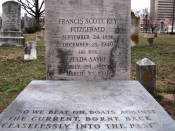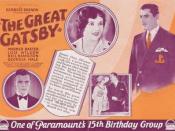In the epic novel The Great Gatsby by F. Scott Fitzgerald, a naïve Midwestern boy trying to make it in New York City, Nick Carraway, narrates a story complete with many underlying themes relating to 1920's society. The main focus of the story is the negative effects of the obsession with materialism and 'The American Dream'. Throughout the novel, Fitzgerald makes the evils of greed and materialistic desires apparent by making all the characters lives miserable and empty- a philosophic statement about the typical American viewpoint of money and possessions.
If we look back to the time when The Great Gatsby was written back in 1925, America was full swing into what is referred to as "The Jazz Age". During this post World War I time, the attitude of the typical American was highly ambitious: New millionaire tycoons were springing up everywhere, the stock market was flying high, and 'new money' was popping up everywhere.
"A portrait of the Jazz Age in all of its decadence and excess, Gatsby captured the spirit of the author's generation and earned itself a permanent place in American mythology."(Amazon). It is because of this economic trend that Americans became so money-hungry, and it is this negative almost anti-glamorous life that Fitzgerald so vividly describes and warns against in The Great Gatsby.
The story opens with Nick Carraway moving from Minnesota to New York City with an appetite for money but still retaining his morals. He moves into the West Egg part of Long Island, which is populated by 'new money' people, or those who have the financial means to be considered rich but lack the social connections of the 'old money' residents of the East Egg. Nick's sole connection to the East Egg is through his cousin, Daisy, and her husband, Tom.



American dream
The american dream in whatever form it takes has its root in the illusion of happiness. You should've displayed Gatsby as a victim of the times and of societies misconception of what happiness really is rather than paint a picture of a money hungry man. I found it very comprehensive and well structured.
1 out of 1 people found this comment useful.